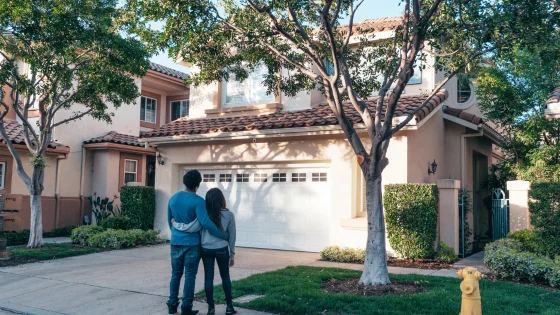Buying your first home is a milestone worth celebrating, but it’s not without its financial surprises. Many first-time buyers focus solely on the down payment, only to be caught off guard by the hidden costs of buying a home. To help you prepare, we’ve created this guide to navigate these often-overlooked expenses and make your home buying journey smoother and more informed.
The Reality of Hidden Costs for First-Time Homebuyers
Most first-time buyers underestimate the true cost of homeownership. Beyond the sticker price, there are numerous additional expenses that can strain your budget and potentially disrupt your financial plans.
- Why it matters: Overlooking these hidden costs can lead to financial stress and unexpected debt, potentially delaying your long-term goals.
- Common mistake: Assuming that the down payment and mortgage are the only major financial commitments involved in buying a home.
Understanding the hidden costs of buying a home is crucial to making informed decisions. From closing costs for new homeowners to ongoing maintenance and unexpected fees, these expenses can add up quickly and should not be ignored. A well-prepared buyer can navigate these hurdles confidently and avoid unnecessary financial strain.
Closing Costs: The Final Hurdle
Closing costs often catch first-time buyers by surprise. These fees are paid at the end of the transaction and can range from 2% to 5% of the home’s purchase price, depending on various factors.
What’s Included in Closing Costs?
- Loan Origination Fees: Charged by lenders to process your loan application and paperwork.
- Title Insurance: Protects against legal disputes over property ownership and ensures you have clear title to your home.
- Appraisal Fees: Covers the cost of determining the home’s market value and is required by your lender.
- Attorney Fees: If applicable, these fees cover legal services provided during the transaction.
- Recording Fees and Taxes: Charged by local government offices to record the property transfer.
Tips to Manage Closing Costs:
- Shop Around: Compare lenders to find lower fees and more competitive loan terms.
- Negotiate: Some fees, such as title insurance or application fees, may be negotiable—don’t hesitate to ask.
- Budget Wisely: Include closing costs in your overall financial plan and save accordingly to avoid last-minute surprises.
- Ask About Seller Contributions: In some cases, sellers may agree to cover a portion of the closing costs to close the deal faster.
By understanding and preparing for closing costs, you can reduce stress and ensure you’re financially ready for this final step.
Property Taxes: An Ongoing Commitment
Property taxes are an unavoidable cost of homeownership and can vary significantly depending on your location. These taxes are based on the assessed value of your home and are used to fund local services like schools, infrastructure, and emergency services.
Understanding Property Taxes:
- Annual Expense: Property taxes are typically paid annually or semi-annually, depending on local regulations.
- Escrow Accounts: Many lenders require you to have an escrow account for property taxes, which means a portion of your monthly mortgage payment will be allocated toward these taxes.
- Fluctuations: Property taxes may increase over time as your home’s assessed value rises or if local tax rates change.
Plan Ahead:
Research property tax rates in the area where you’re planning to buy. Understanding the annual tax burden can help you factor this into your long-term budget and prevent unpleasant surprises later. It’s also wise to ask your lender about how property taxes are managed through your escrow account.
Home Inspection Fees: An Essential Step
A home inspection is a critical step in the buying process, ensuring the property is in good condition before you commit to the purchase. While it’s an additional cost, skipping this step can lead to costly mistakes.
Why It’s Important:
- Uncover Issues: A thorough inspection can identify potential problems like structural damage, electrical issues, or plumbing concerns that might otherwise go unnoticed.
- Negotiation Tool: If significant issues are found, you can use the inspection report to negotiate repairs or request a lower purchase price.
- Peace of Mind: Knowing the home’s condition helps you plan for future maintenance and repairs.
Cost of Home Inspections:
- The average cost ranges from $300 to $500, depending on the home’s size and location. Larger or older homes may require specialized inspections, which can increase the cost.
Skipping the inspection may save a few hundred dollars initially, but it could result in unforeseen repair costs down the road. It’s an investment in your future peace of mind.
Moving Expenses: More Than Just the Truck
Relocating to your new home involves more than renting a moving truck, and these expenses can quickly add up if not carefully managed.
What to Expect:
- Professional Movers: Hiring a moving company can cost anywhere from $500 to $5,000, depending on the distance, volume of belongings, and additional services such as packing and unpacking.
- Packing Supplies: Boxes, tape, bubble wrap, and other materials can cost $100 or more, depending on your needs.
- Utility Transfers: Setting up utilities like electricity, water, and internet in your new home often comes with activation fees, which can range from $50 to $200 per service.
- Storage Costs: If your move is delayed, you may need to rent a storage unit, which adds another layer of expense.
Save on Moving Costs:
- DIY Moving: Rent a truck and handle the move yourself, especially for shorter distances.
- Declutter: Reduce moving costs by selling or donating items you no longer need.
- Compare Quotes: Get estimates from multiple moving companies to find the best deal.
- Plan Off-Peak Moves: Moving during off-peak seasons or mid-week can help lower costs.
Maintenance and Repairs: The Long-Term Commitment
Owning a home means taking on the responsibility of maintenance and repairs, which are often overlooked by first-time buyers. These costs can be substantial and are a necessary part of homeownership.
Common Costs:
- HVAC Maintenance: Regular servicing can cost $100 to $300 annually but can extend the life of your system and improve efficiency.
- Roof Repairs: Minor repairs can range from $150 to $1,000, while a full replacement may cost $10,000 to $20,000 or more.
- Plumbing Repairs: Fixing leaks, clogged drains, or broken pipes can cost $150 to $500 per incident.
- Appliance Repairs: Repairing or replacing appliances like refrigerators, washers, or stoves can cost hundreds to thousands of dollars, depending on the issue.
Proactive Planning:
- Create a Maintenance Fund: Set aside 1% to 2% of your home’s value annually to cover maintenance and repair costs.
- Schedule Inspections: Regularly inspect key systems like HVAC, plumbing, and roofing to address minor issues before they become major problems.
- DIY Skills: Learning basic repair skills can save you money and reduce your reliance on professionals for minor fixes.
Homeowners Insurance: Protecting Your Investment
Homeowners insurance is a non-negotiable expense that protects your property and belongings from unexpected events, such as fires, storms, or theft. Understanding your policy and coverage is essential to avoid gaps in protection.
Factors Affecting Costs:
- Location: Homes in areas prone to natural disasters like hurricanes or earthquakes often have higher premiums.
- Coverage Levels: Additional coverage for valuable items like jewelry or art increases costs.
- Home Features: Older homes or homes with outdated systems may cost more to insure.
How to Save:
- Bundle Policies: Combine home and auto insurance to receive discounts from your provider.
- Increase Deductibles: Opting for a higher deductible can lower your premium, but make sure you can afford the out-of-pocket cost.
- Improve Home Safety: Installing smoke detectors, security systems, and other safety features can reduce premiums.
HOA Fees: Living in a Managed Community
If you’re buying a home in a neighborhood with a homeowners association (HOA), you’ll need to budget for monthly or annual fees. These fees contribute to community maintenance and amenities.
What HOA Fees Cover:
- Maintenance: Landscaping, snow removal, and upkeep of shared spaces like parks or sidewalks.
- Amenities: Access to community amenities such as pools, gyms, or clubhouses.
- Special Assessments: Occasionally, HOAs may charge additional fees for major repairs or improvements.
Before You Buy:
- Research HOA Rules: Understand the association’s regulations and how they may impact your lifestyle.
- Factor into Budget: Include HOA fees in your monthly expenses to ensure they fit within your financial plan.
- Attend Meetings: Attend HOA meetings to stay informed about upcoming changes or potential fee increases.
The Importance of Financial Cushioning
Finally, it’s essential to have a financial safety net for unexpected expenses that arise after buying a home. Without this cushion, even minor emergencies can create financial strain.
Why It Matters:
- Emergency Repairs: Sudden issues, such as a broken water heater or roof leak, can be costly and need immediate attention.
- Peace of Mind: A financial cushion allows you to address unexpected expenses without derailing your budget or accumulating debt.
How to Build It:
- Start Early: Begin saving as soon as you start house hunting to build your emergency fund gradually.
- Set Realistic Goals: Aim for three to six months of living expenses to cover emergencies.
- Automate Savings: Set up automatic transfers to a dedicated savings account to build your fund consistently.
Knowledge is Power
Understanding the hidden costs of buying a home can save you from unpleasant surprises and help you plan better for the future. By budgeting for these expenses and preparing for the unexpected, you’ll be better equipped to enjoy the journey of homeownership. Remember, being a first-time homebuyer is a learning experience, and preparation is key to success. Take the time to educate yourself, ask questions, and plan ahead so you can confidently step into this exciting new chapter of your life.


